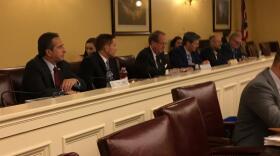For the first time in a decade, state officials are poised to miss the deadline to get the two-year operating budget to the governor for his signature.
Ohio Public Radio's Karen Kasler reports.
Ten years ago, Ohio was in a precarious position.
“Each day that passes is putting us into a deeper financial hole,” said Democratic former Gov. Ted Strickland in July 2009, when he was locked with lawmakers in a budget stalemate that dragged on for two weeks.
Strickland’s first budget two years before had passed almost unanimously. But the Great Recession had blown a hole in the budget, and unemployment was at a record high 11.2 percent. And the solution was slot machines, a billion dollars taken from the state’s rainy day fund, major budget cuts and layoffs and a delay in the final year of a tax cut. So the atmosphere was bitterly partisan as both Republicans and Democrats were preparing for the 2010 elections.
Marc Kovac covers Franklin County government and federal courts for the Columbus Dispatch. Then he was the Statehouse Bureau Chief for Dix Newspapers, and shooting what he often called “shaky video” for his Youtube channel Ohio Capital Blog.
“It was much more contentious during that Republican Senate-Democratic House session, and that led into Strickland losing to John Kasich and led to the Democrats to losing their majority in the House,” Kovac said.
Ten years later, the jobless rate is at its lowest level in 18 years, there’s $2.7 billion in the rainy day fund and a budget surplus of more than $600 million. The House budget passed overwhelmingly and sailed through the Senate unanimously. But there’s no final budget deal in sight.
And the 2020 election is around the corner, but the governor isn’t up for re-election yet and the Senate president is term-limited, though the Speaker will be on the ballot.
Speaker Larry Householder (R-Glenford) said there are big differences on Medicaid and education between the budgets. But the 6.6 percent income tax cut in the House budget became an 8 percent cut in the Senate, and while the House decided many small businesses could take only the first $100,000 of their incomes tax free, the Senate restored that deduction back to its current level of $250,000. And Householder said he’s worried.
“I think it’s smart for us right now, while we do have cash coming in, to be looking forward and saying, ok, we can prepare ourselves for a downturn and not make this one of these situations where it’s boom and bust, where you have to do things like raise taxes in a recessionary time, or you have to drastically cut spending in recessionary times,” Householder said.
In the Senate, there’s a different view.
“I think the tax cut is absolutely sustainable over time and frankly, if anyone thought that it wasn’t, I don’t think that we would have had a 33-0 vote," said Senate President Larry Obhof (R-Medina).
He said his chamber leveraged more federal dollars to get the income tax cut and restore the small business tax break. And he notes there’s still that budget surplus.
“I do think that the tax cut that the Senate had was appropriate. I think you saw significant spending in this bill, and significant growth in spending in this bill. And our revenues still exceeded that. So I think if you’re able to do the things that the Governor and the House and the Senate flagged as priorities for the state but bringing in extra money, then that means your tax rate is a little bit too high,” Obhof said.
Obhof said there are nearly 600 points of difference between the two budgets, which is less than in the last budget cycle. So both sides are hopeful the state won’t have to go to one-week interim budgets, as happened in 2009.
But Householder said there are two amendments that have been drafted to a school construction funding bill: “One is, would be a 90-day extension on the workers’ comp budget, and the other would be a 14-day extension on the operating budget.”
The Bureau of Workers’ Compensation budget is also supposed to be signed by June 30. But the Senate stripped out some provisions the House added on post-traumatic stress disorder claims by first responders and on immigration status disclosures by injured workers.
Earlier this year, a dispute over a gas tax increase between lawmakers and the governor delayed the signing of that budget till three days after the March 31 deadline. Out of the four budgets the state has in a budget year, only one has been signed on time so far – Gov. Mike DeWine signed the Industrial Commission budgeton Thursday.







